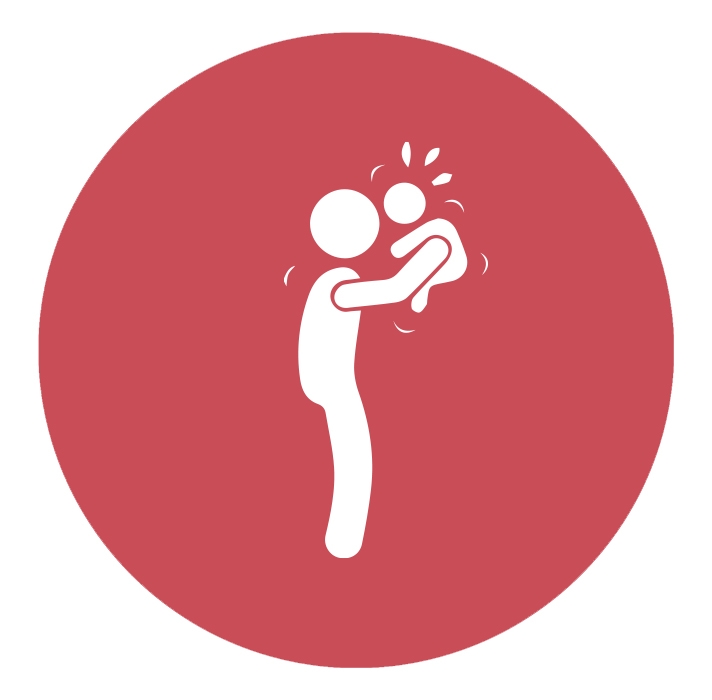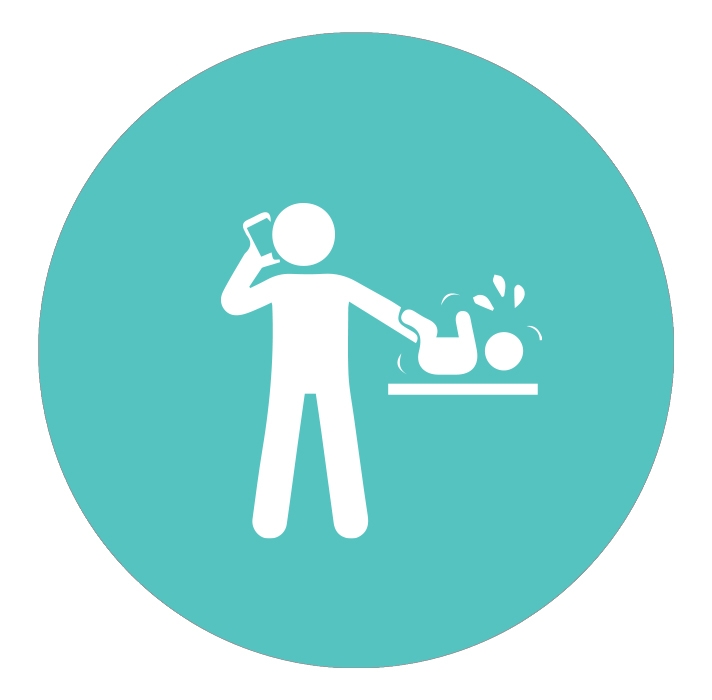Shaken Baby Syndrome Prevention
Child abuse needs to stop and education is the key.
The following free resources are essential to driving change and
are made possible through your contributions. Thank you.

Never Shake A Baby!
Crying is Normal. Shaking is not.
Steps for Prevention

Put Baby in
a safe place

Walk
Away

Take A
Time Out

Ask For
Help!
PREVENTING SHAKEN BABY SYNDROME
Shaken Baby Syndrome (SBS) is preventable. The definition of shaken baby syndrome is quite simple; it is a severe form of physical child abuse resulting from violent shaking of an infant by the shoulders, arms, or legs. SBS may result from both shaking alone or from shaking with impact.
Babies, newborn to one year (especially babies ages 2 to 4 months), are at greatest risk of injury from shaking. Shaking them violently can trigger a “whiplash” effect that can lead to internal injuries—including bleeding in the brain or in the eyes. Often there are no obvious external physical signs, such as bruising or bleeding, to indicate an injury.
The number one reason a child is shaken is because a parent or caregiver becomes so frustrated with a baby’s crying that they lose control and begin to shake them. They are usually average people, who in the heat of their frustration and anger lose control, and shake their child. Most people charged with shaking their baby have no previous history of violence, and the act is unintended. However, the effects of shaken baby syndrome can still be severe.
Read more from the CDC’s SHAKEN BABY SYNDROME, A PREVENTATIVE TRAGEDY.
Signs and Symptoms OF SHAKEN BABY SYNDROME
Immediate SYMPTOMS of Shaken Baby Syndrome (SBS) include tiredness, not eating, no smiling, talking or laughing, difficulty swallowing, sucking or breathing, vomiting, difficulty staying awake, or the baby is very stiff or limp like a rag doll.
SHAKING CAN CAUSE serious effects including brain injury, cerebral palsy, blindness, hearing loss, learning and behavior problems, seizures, paralysis, and death.
It is estimated that 1,000-3,000 children in the United States suffer from Shaken Baby Syndrome (SBS) each year.
ONE FOURTH of victims of SBS die, and 80 PERCENT of survivors suffer from permanent damage.
Approximately 20/100,000 CHILDREN sustain Abusive Head Trauma annually.




Signs and Symptoms
Immediate SYMPTOMS of Shaken Baby Syndrome (SBS) include tiredness, not eating, no smiling, talking or laughing, difficulty swallowing, sucking or breathing, vomiting, difficulty staying awake, or the baby is very stiff or limp like a rag doll.
SHAKING CAN CAUSE brain injury, cerebral palsy, blindness, hearing loss, learning and behavior problems, seizures, paralysis, and death.
It is estimated that 1,000-3,000 children in the United States suffer from Shaken Baby Syndrome (SBS) each year.
ONE FOURTH of victims of SBS die, and 80 PERCENT of survivors suffer from permanent damage.
Approximately 20/100,000 CHILDREN sustain Abusive Head Trauma annually.
CRYING & COLIC ARE NORMAL
SHAKING IS DANGEROUS!
Steps for Prevention
The crying…the late-night feedings…the constant changing of diapers…the resulting exhaustion… The fact is that many new parents and caregivers find themselves unprepared for the realities of caring for a baby and the stress and aggravation that can accompany those realities.
Crying—including prolonged bouts of inconsolable crying— is normal developmental behavior in babies. It helps to think of crying as one of the ways babies communicate.
First, understand that crying is a normal developmental stage. The Period of PURPLE Crying begins at about 2 weeks of age and continues until about 3-4 months of age. There are other common characteristics of this phase, or period, which are better described by the acronym PURPLE. All babies go through this period. It is during this time that some babies can cry a lot and some far less, but they all go through it.


The crying has a beginning and an end.
STAY CALM | DE-STRESS | ASK FOR HELP
The best thing that parents and caretakers can do is stay calm. It may sound simple, but it can be hard to do when you are tired, frazzled, and worried about your baby. Taking care of a crying infant is a lot of work, and feeling frustrated, drained, and a little desperate is a normal reaction to a hard situation. It is okay to feel those things; the trick is to not let your feelings shape how you treat your baby. Keeping your emotions in check – staying calm – is important for your own sake, but also for your baby. NEVER shake a baby!
Try to take at least 15-30 minutes alone each day. Take a walk or to do something relaxing and enjoyable. Ask your partner, family or friends to take care of the baby while you take care of yourself; it’s difficult to be calm and at your best when you are overtired and stressed.
Learn how to breathe deeply and become aware of how much stress is held in the body. Both caretaker and child can benefit significantly when the caretaker utilizes relaxation and visualization or other mindfulness techniques on a regular basis. When the caretaker is more relaxed, the child’s sense of well being, trust, and secure attachment to the parent is enhanced.


Parental education is crucial for prevention of more cases of shaken baby syndrome.
The abuse may be brief, but the trauma lasts a lifetime.
Kids’ lives and futures are on the line!
Be the voice against neglect and contribute to end child maltreatment today.
Our Lessons are available for Offline learning!
Previous Section
Parenting Resource Center
Shaken Baby Syndrome Prevention
Next Section
